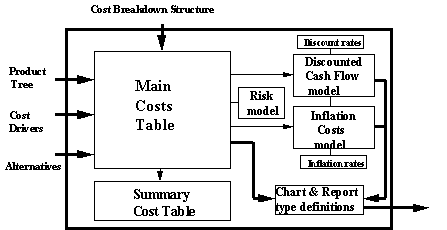ATCost- our new life-cycle costing system |
|||

|
IntroductionThe ATCost life-cycle costing system has been developed by Eagle Vector to enable senior managers to understand and control the costs of implementing and supporting major systems without the need to be directly involved in low level bottom-up costing work. ATCost can be applied right from the initial concept stage of a new project and used during all subsequent phases. EV has much experience in the development of major systems; for example, it has worked for many years with the UKís National Air Traffic Services (NATS) and has provided support to its major projects. ATCost is a generic ATC modelling system that can be tailored to match the specifics of client projects. EV can supply the modelling system together with consultancy and training to support the use of ATCost. The system has been implemented to run on PC systems with Windows and consists of a number of modules. The key modules are implemented using Microsoft Office tools and these are combined with the use of off-the-shelf proprietary low level costing tools. As appropriate and if the client prefers, other proprietary costing tools can be integrated into ATCost. An overview of the system is shown below. 
ATCost consists of the following major elements :
Master Cost Breakdown Structure modelAt the heart of the system is the Cost Breakdown Structure (CBS). The CBS contains all the cost items that go to make up the cost of the system over the complete lifecycle - broken down to the level at which costs can need to be made visible and be controlled. It is important that the CBS covers all costs; normally included in the CBS will be not only the direct costs of acquiring and supporting the system but also costs involved in training personnel, constructing support facilities etc. We have developed a generic model that is applicable to a wide range of ATC systems. The first step in applying this model is to review the CBS against the needs of the client and his specific projects. ATCost enables costs to be broken down over monthly and annual periods. It can be customised to cater for other financial accounting periods. In the main costs table, costs are usually entered at todayís cost rates. However, most costs are susceptible to inflation and ATCost can automatically calculate the effects of inflation. Inflation rates are available for each costing period. In addition, since inflation rates for equipment and staff, for example, can be different, five separate inflation rate tables are available and the appropriate one set for each item in the cost table. In making the decision about the most appropriate system where costs to the customer are spread over a number of years, the Net Present Value (NPV) concept extremely useful for supporting the selection of the most cost-effective solutions. ATCost supports NPV and a table is available containing discount rates for each costing period. Proprietary and custom low-level estimating toolsATCost supports two major approaches to building bottom-up estimates of the cost information needed to populate the master CBS table :
Parametric models make use of linear and non-linear cost estimating functions in order to calculate cost data. They can be used from the initial concept stage of a project. ATCost can use custom-designed parameter cost estimating models and the proprietary PRICE True Planning tools. Other proprietary tools can be integrated into ATCost. Analogous cost estimating is based on the use of historical project and product data where similarities can be seen to exist with the project being costed. The ATCost Project & Product database provides input data for this modelling. Many of todayís major systems make extensive use of Commercial Off-the Shelf (COTS) software and hardware items. EV supplies acquisition and support data in respect of COTS items through Projects & Products database User InterfaceATCost provides a simplified user interface in order to :
Project & Products databaseThe object of the database is to provide cost data on
There are a number of routes to populating this database. Some of the data is generic - based on EVís previous experience. Some can be specific to the nature of the project. EV has been involved in numerous actual major projects for clients; naturally this data is initially confidential, but EV will be happy to discuss with the owners of this data the possibility of making the data available to particular ATCost users. Also, data on a clientís own previous projects may be collected, analysed and included in the database.
|
|

Last modified 28/04/10 by maia@eaglevector.com